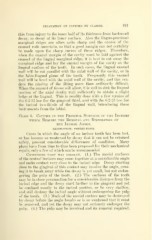Page 431 - My FlipBook
P. 431
EXCAVATION OF CAVITIES BY CLASSES. 191
thin from injury to the inner half of its thickness from backward
decay, or decay of its inner surface. Also the linguo-proximal
marginal ridges are often quite sharp and the course of the
enamel rods uncertain, so that a good margin can not certainly
be made upon the sharp curves of these ridges. Therefore,
when the enamel margin of the cavity must be laid against the
enamel of the lingual marginal ridge, it is best to cut away the
marginal ridge and lay the enamel margin of the cavity on the
lingual surface of the tooth. In such cases, the lingual enamel
wall will be cut parallel with the axial wall of the cavity, or in
the labio-lingual plane of the tooth. Frequently this enamel
wall will be level with the axial wall of the cavity, and this ren-
ders the placing of the filling more than ordinarily difficult.
When the amount of tissue will allow, it is well to sink the lingual
portion of the axial dentin wall sufficiently to obtain a slight
ledge at the lingual. This is readily done with a few strokes of
the 6-2-12 hoe for the gingival third, and with the 6-2-23 hoe for
the incisal two-thirds of the lingual wall, introducing these
instruments from the labial.
Class 4. Cavities in the Proximal Surfaces of the Incisors
WHICH Require the Removal and Restoration of
the Incisal Angle.
illustrations: figures 272-280.
Cases in which the angle of an incisor tooth has been lost,
or has become so weakened by decay that it can not be retained
safely, present considerable differences of condition. Many
plans have from time to time been proposed for their mechanical
repair, only a few of which can be recommended
Conditions that may present. (1.) The mesial surfaces
of the central incisors may come together at a considerable angle
and make contact very close to the incisal edge. Decay starting
close to the gingival of this contact may involve the angle, caus-
ing it to break away while the decay is yet small, but not endan-
gering the pulp of the tooth. (2.) The surfaces of the teeth
may be in close proximation for a considerable distance from the
incisal edge anci the decay start farther to the gingival and yet
be confined mostly to the incisal portion, or be very shallow,
and still destroy the incisal angle without endangering the pulp
of the tooth. (3.) Much of the mesial surface may be destroyed
by decay before the angle breaks or is so weakened that it must
be removed, and yet the decay may not seriously endanger the
pulp. (4.) The pulp may be involved and its removal required.


